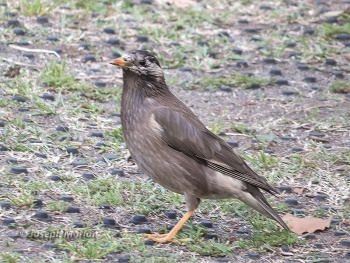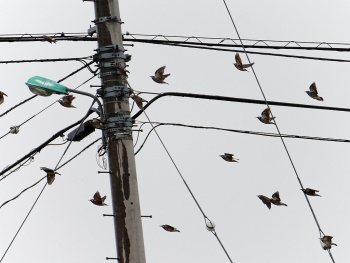Alternative names: Gray Starling, Grey Starling, Ashy Starling
- Spodiopsar cineraceus
Poliopsar cineraceus; Sturnus cineraceus
Identification
22cm (9.5"). A medium-sized, brownish-grey starling.
- Head and throat black with white grizzling, the latter concentrated in white cheek patches
- Back, lower breast and belly dark grey
- Wings dark grey with blackish primaries, a narrow white wing-bar on secondaries
- Vent and rump white, the latter noticeable in flight
- Tail blackish-grey, with white tips on outer feathers
- Bill yellow with a black tip, feet orange
- Elongated throat and nape feathers often give this bird a disheveled appearance.
Sexes similar. Females are more uniformly grey-brown lacking the contrasting black throat and chest. Juvenile has grey head with more extensive white cheeks and throat.
Distribution
Breeds in southeast Siberia, Mongolia, northern China, Korea, southern Sakhalin and Japan.
Parts of the population winter in southern China (including Hainan) and Taiwan. Recorded as vagrant in Burma, Thailand and the Philippines.
Common to very common in most of its range.
Taxonomy
This is a monotypic species. This species and the Red-billed Starling of China have been moved from Sturnus into the genus Spodiopsar. based on molecular findings by Loveette et al. and Zuccon et al.[4][5] Sometimes placed in the genus Poliopsar.
Habitat
Prefers open country and cultivated areas with scattered trees.
Behaviour
Diet
Omnivorous, feeds mainly on invertebrates and insects.
Forages in flocks, feeding largely on the ground.
Breeding
Breeding season from April to July. A monogamous species, nesting in colonies of up to 30 pairs. The untidy nest is placed in a tree hole, under house eaves or in nestboxes. In Mongolia also known to excavate its own hole in a sandy steep riverbank. Lays 2 - 10 eggs. Interspecific brood parasitism occurs, the females laying their eggs in nests of Purple-backed Starlings. Existing eggs are not removed resulting in some very large clutches.
Vocalisation
Call: A creaky chir-chir-chay-cheet-cheet.
Movements
Most populations migratory, resident in Japan.
References
- Clements, J. F., T. S. Schulenberg, M. J. Iliff, D. Roberson, T. A. Fredericks, B. L. Sullivan, and C. L. Wood. 2018. The eBird/Clements checklist of birds of the world: v2018. Downloaded from http://www.birds.cornell.edu/clementschecklist/download/
- Del Hoyo, J, A Elliott, and D Christie, eds. 2009. Handbook of the Birds of the World. Volume 14: Bush-shrikes to Old World Sparrows. Barcelona: Lynx Edicions. ISBN 978-8496553507
- Craig, A. & Feare, C. (2017). White-cheeked Starling (Spodiopsar cineraceus). In: del Hoyo, J., Elliott, A., Sargatal, J., Christie, D.A. & de Juana, E. (eds.). Handbook of the Birds of the World Alive. Lynx Edicions, Barcelona. (retrieved from http://www.hbw.com/node/60854 on 3 June 2017).
- Lovette, I.J., B.V. McCleery, A.L. Talaba & D.R. Rubenstein. (2008). A complete species-level molecular phylogeny for the Eurasian starlings (Sturnidae: Sturnus, Acridotheres, and allies): recent diversification in a highly social and dispersive avian group. Molecular Phylogenetics and Evolution 47:251-260.
- Zuccon, D., E. Pasquet & P.G.P. Ericson. (2008). Phylogenetic relationships among Palearctic-Oriental starlings and mynas (genera Sturnus and Acridotheres: Sturnidae). Zoologica Scripta 37:469-481.
Recommended Citation
- BirdForum Opus contributors. (2025) White-cheeked Starling. In: BirdForum, the forum for wild birds and birding. Retrieved 5 February 2025 from https://www.birdforum.net/opus/White-cheeked_Starling







